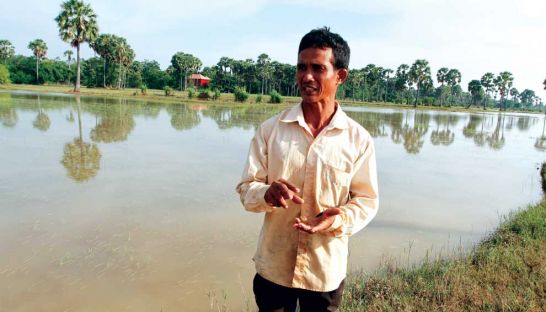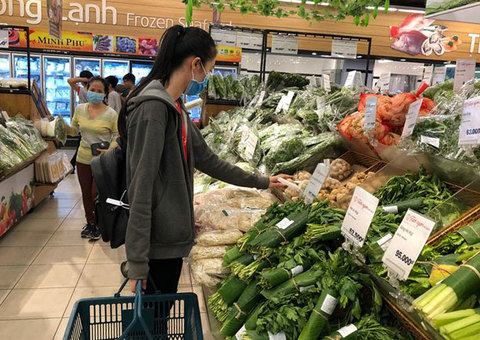Debts rise along with water level
Debts rise along with water level
With pant legs rolled up to his knees, Hoeuy Mon trudges through a brown and green patchwork of rice fields.

His four hectares are in Tkov village, Prey Veng province, about 300 metres from his home. On most of the journey, walkways enclosing each square plot are either submerged in water or ruined. Flooding has destroyed half of the latest crop.
“For the rest of the fields, the yield has also decreased, as you can see, to about 50 per cent,” he said, while moving through waterlogged vegetation.
The losses mean fewer crops, smaller returns, and above all, fears of crippling debt.
Four months ago, Mon took out a $3,000 loan, over half of which went for seed, pesticides and fuel to fund paddy production for the rainy season.
But with crops damaged and the harvests of workable areas delayed, Mon is in danger of falling behind on payments, relying on a small snack business of his to try and fill the gap. In good times, Mon should earn at least $800 per hectare of paddy rice. The paddy is then sold to middlemen who sell it on to millers, giving Mon enough to cover the cost of production and loan payments, while making a small profit. Now, if he’s lucky, he’ll see less than half his usual amount.
“I am worried, but I need to pay it back. I will find a way to pay it all back,” he said.
Farmers across the country are facing similar financial crises as rising waters from the Mekong inundate crops and cancel out the value of harvests. The problem is increasingly coming to resemble the aftermath of flooding in 2011, when widespread debt took hold of agricultural communities.
Some farmers who couldn’t pay lost their land, and the government intervened to delay loan deadlines.
Mon remembers 2011. Waters rose to 8.2 metres above normal levels across Prey Veng province, and he lost his first rainy season crop.
Cambodian Economic Association president Srey Chanty, who has been visiting flood-affected areas throughout Cambodia, said farmers have “borrowed a lot” to fund this wet season’s production.
According to Chanty, microfinance institutions are struggling to meet the demand, causing many farmers to turn to informal lenders, some of whom require more collateral and charge higher interest rates.
“I think the flood this year is very bad; it is almost worse than 2011,” he said.
Back then, flooding affected 1.64 million people, with nearly 51,600 homes evacuated and 247 people killed, according to the National Committee for Disaster Management. More than 420,000 hectares of Cambodia’s nearly 2.5 million rice fields were impacted, and more than 10 per cent were destroyed.
The Asian Development Bank estimated that the cost of damage caused by the 2011 floods was $624 million. While more than half of this was road and bridge damage, almost $180 million was agricultural, mostly rice.
At the time, the financial pressures prompted the government to meet with microfinance institutions to request more flexible repayment arrangements to cope with increased household debt.
Authorities say it is too early to predict the extent of this year’s damage, but initial government estimates of land affected or at risk put the figure at more than 120,000 hectares and rising.
The death toll passed the 100 mark this week.
Several farmers who spoke to the Post in Prey Veng said that debt was leaving them little choice other than to find buyers for household items.
“We have a headache right now. I am trying to sell my moto to pay back the money that I owe,” 41-year-old farmer Sum Sam said.
Sam owes $1,000 to an informal lender after his four hectares in Svay To district of Prey Veng were destroyed.
His neighbour, widower Chamroen Sreyneang, says she is also looking to sell her moto to pay back the $875 she invested in 3.5 hectares.
“I need to take another loan to restart my farm and for food as well.”
Well aware of the debt problems that occurred after the 2011 floods, Seang Soleak, regional communications officer at relief agency Oxfam, said that farmers are “vulnerable” to unexpected natural disasters and at risk of spiraling in to debt.
“In addition to a loan that they took earlier, farmers are having to take out two or more loans,” he said.
Loans at microfinance institutions rose 46 per cent to $644 million in response to 2011 flooding, according to National Bank of Cambodia data.
Since most of the recent loans were taken out in July, August and September, up-to-date data is not yet available. The increased presence of informal money lenders in the sector also makes it difficult to put a figure on how much debt is out there, but anecdotal evidence is powerful.
In Tkov village, where Mon lives, he says “99 per cent” of villagers are in debt.
“I will try to sell more bread and raise more chickens,” he said.
phnompenh post














